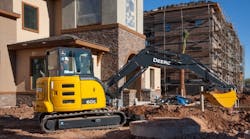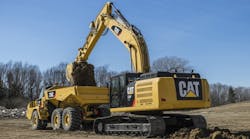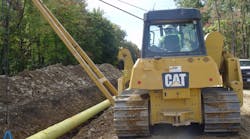Housing starts plummeted 11% at a seasonally adjusted annual rate from November (1,214,000 units) to December (1,078,000 units), the Census Bureau reported on Tuesday. The "drop in overall starts marked the third decline in the past four months and was the largest monthly decline since June," Wells Fargo Economics noted in a commentary. "Starts of multifamily units, which are extremely volatile, tumbled 20%, following a 16% rise the prior month. Multifamily starts finished the year with a 5.6% gain relative to 2017, which was better than expected given earlier concerns about apartment overbuilding. Apartment demand proved stronger than expected in 2018, however, which has given apartment construction a second wind.
Multifamily permits rose 4.9% in December, marking their third consecutive increase. Multifamily permits have averaged a 463,000-unit pace over the past three months, nearly 30% more than starts, which averaged just a 363,000-unit pace. The gap suggests multifamily starts are poised to rebound in early 2019. Single-family starts plunged 6.7% in December, following a 5.9% drop the prior month. Single-family starts also fell in September and October." Single-family permits in December slipped 2.2% from November and 5.5% year-over-year. For the year as a whole, permits climbed 2.2% from 2017, with single-family permits up 4.0% and multifamily down 1.0%.
"Construction costs increased in February" for the 28th month in a row, IHS Markit and the Procurement Executives Group reported on Wednesday. "Materials and equipment prices rose in February,...with price increases recorded in eight of the 12 subcomponents. Similar to last month, steel categories had weak or flat pricing: prices for alloy steel pipe remained the same, while prices for fabricated structural steel and carbon steel pipe fell. [Prices] increased significantly for downstream products such as pumps and turbines. 'While steel costs are coming down right now, price hikes from the summer and fall are now filtering down to turbines and pumps,' said Thomas McCartin, senior economist, pricing and purchasing, IHS Markit. 'Steel prices are an important input cost for these products. Higher input costs, coupled with increasing demand from the energy industry, are putting upward pressure on these materials.' Current subcontractor labor costs registered increases once again."
Inflation-adjusted gross domestic product (real GDP) increased 2.6% at a seasonally adjusted annual rate in the fourth quarter (Q4) of 2018, following a 3.4% gain in Q3, the Bureau of Economic Analysis (BEA) reported on Thursday. Real gross private domestic investment in nonresidential structures (including wells and mines) decreased 4.2% (vs. a 3.4% decrease in Q3). Real investment in commercial and health care structures declined -4.2% (vs. -5.6%); manufacturing structures, -9.0% (vs. 16%); power and communication structures, -17% (vs. -8.7%); and other non-mining structures, 9.6% (vs. 5.1%). Real residential investment declined 3.5% (vs. -3.6%). Real investment in single-family structures decreased 14% (vs. -5.5%); investment in multifamily structures increased 26% (vs. -8.7%). Real government gross investment in structures decreased 5.2% (vs. a 5.0% increase in Q3). Federal investment decreased 9.1% (nondefense structures, -13%; defense structures, 5.3%) while state and local investment decreased 5.0%. The GDP price index increased 1.8% in Q4 (and in Q3). The price index for nonresidential structures investment climbed 6.0% (vs. 3.1%). The price index for residential investment rose 3.0% (vs. 3.6%). The price index for residential investment rose 3.0% (vs. 3.6%). The price index for government investment in structures rose 4.9% (vs. 4.3%). This "initial estimate," BEA noted, "is based on source data that are incomplete or subject to further revision" because the federal shutdown delayed release of many components.
"Demand for student housing remains strong, even as the economy approaches full employment, luring some potential students away from school and into the workforce," the National Real Estate Investor "Student Housing Newsletter" reported on Tuesday. "'Admissions demand remains incredibly high at America's top public universities, which translates into strong and often growing demand for students housing,' although 'there certainly are several over-built student housing markets around the country,' says Frederick Pierce, president and CEO of Pierce Education Properties, an investor in, developer and manager of student housing assets based in San Diego....developers plan to build fewer new beds. 'Recent reductions of new deliveries to volumes at about half of the bullish years of 2013 and 2014 demonstrates market prudence and porten[d]s well,' says Pierce. Developers finished a total of 47,000 new off-campus student housing beds for the fall of 2018. Developers are also starting construction on 30,900 beds for the fall of 2019, with 10,000 additional beds identified but not started, according to Axiometrics." Another article in the same issue reports, "In the fall of 2018, a total of nearly 9,000 beds were delayed in delivery at 21 properties, according to a count from research firm Axiometrics....To open their properties on time, developers are willing to also pay more to get enough workers. Wages per hour are rising significantly faster than inflation.
'With the current highly competitive landscape, there are less sub-contractors bidding jobs and we are seeing a high volume of pricing variability for the same trades,' says Todd Benson, managing director of development and asset management at PEBB Capital, a real estate and private equity investment firm. Some builders are also paying workers to work overtime. 'Developers are definitely getting creative and buying time in the schedule wherever they can, for example, working on Saturdays and extra manpower allowances,' says Benson. Meanwhile, some development firms have created their own contracting arms. 'Most of the major student housing developers are national in scope and many have critical crews—like framing—in-house and they can transport to their project locations,' says Pierce."
Re-posted from DataDigest, Associated General Contractors of America








